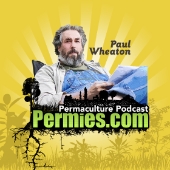
 4
4




Wayne Mackenzie wrote:
Dan Boone wrote:
I would also be looking for (or making a road trip to get seeds for) diospyros texana, the Texas persimmon. From what little I know about them, they seem likely to be better adapted to your biome.
I actually had a Texas seedling for awhile. It just sat there and sulked. I finally pulled it to use the spot for something else.
Pecan Media: food forestry and forest garden ebooks
Now available: The Native Persimmon (centennial edition)
 3
3




Dan Boone wrote:
Doh! Well, that's that, then.
Although to be honest, this is basically the behavior of every American Persimmon tree I've ever planted from seed, too. They don't die, but after five or six years if they aren't perfectly happy with their situation they might easily still be belly-button tall. I've seen feral ones grow much faster, but planted ones just have not done a lot for me.
 2
2




 6
6




If there is one thing the Wizard of Oz has taught me, it is not to trust school teachers on bicycles.
 4
4




 4
4




John F Dean wrote:We planted 2 a couple of years ago. The seem to be taking forever to grow. I this usual?

 4
4




Mary Wildfire wrote:...... Consequently I can't get RID of some growing in my garden or next to my compost bin.
 4
4




Greetings from Brambly Ridge
 3
3




 4
4




"Si hortum in bibliotheca habes, nihil deerit." [If you have a garden and a library, you have everything you need] Marcus Tullius Cicero in Ad Familiares IX, 4, to Varro.
 4
4




Western Shore Life: Proving there's life west of the Chesapeake
Instagram: @westernshorelife
 5
5




A build too cool to miss:Mike's GreenhouseA great example:Joseph's Garden
All the soil info you'll ever need:
Redhawk's excellent soil-building series









Dan Boone wrote:A year ago somebody gave me the suggestion to squeeze the persimmons in one of those zippered mesh laundry bags that has the holes just a bit smaller than your average persimmon seed. It's messy and you need strong hands, but it works really well. Just hold the bag with one hand and work the mass with your other hand. Sticky pulp will accumulate on your hand, so you'll have to scrape that into the bowl as well.
The bags launder well (that's what they are designed for) and are re-usable, though they do stain a bit.




 2
2




 3
3




Saralee Couchoud wrote:I have several wild persimmon trees on my property but not worth the effort. They are all seeds and not much fruit. It is fun to watch the young opossum eating them though. I wonder if a domestic one would be better. Or if there is something I can do to make the wild ones better

"We're all just walking each other home." -Ram Dass
"Be a lamp, or a lifeboat, or a ladder."-Rumi
"It's all one song!" -Neil Young
 4
4




 2
2




 3
3




 3
3




 2
2





|
I will suppress my every urge. But not this shameless plug:
Learn Permaculture through a little hard work
https://wheaton-labs.com/bootcamp
|








